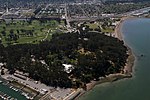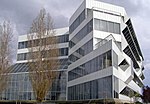Western Air Lines Flight 636

Western Air Lines Flight 636 was a scheduled flight between Los Angeles International Airport and Oakland Municipal Airport in Oakland, California, with an intermediate stop at San Francisco International Airport. Late in the evening of April 20, 1953, the Douglas DC-6B aircraft serving the flight crashed into the San Francisco Bay while making the short flight from San Francisco to Oakland, killing eight of the ten occupants of the plane. Most of the aircraft and two of the victims were never recovered from the bay. An investigation led by the Civil Aeronautics Board (CAB) concluded that the pilot had made errors during the flight while trying to remain below the low cloud cover. The errors resulted in the aircraft descending below the minimum safe altitude and eventually hitting the water. The flight crew may have experienced sensory illusions while flying in the darkness with only the distant lights of the airport ahead to use as a visual reference. This may have led the pilot to believe the aircraft was flying higher than it actually was.
Excerpt from the Wikipedia article Western Air Lines Flight 636 (License: CC BY-SA 3.0, Authors, Images).Western Air Lines Flight 636
South San Francisco
Geographical coordinates (GPS) Address Nearby Places Show on map
Geographical coordinates (GPS)
| Latitude | Longitude |
|---|---|
| N 37.665 ° | E -122.305 ° |
Address
South San Francisco
South San Francisco
California, United States
Open on Google Maps









